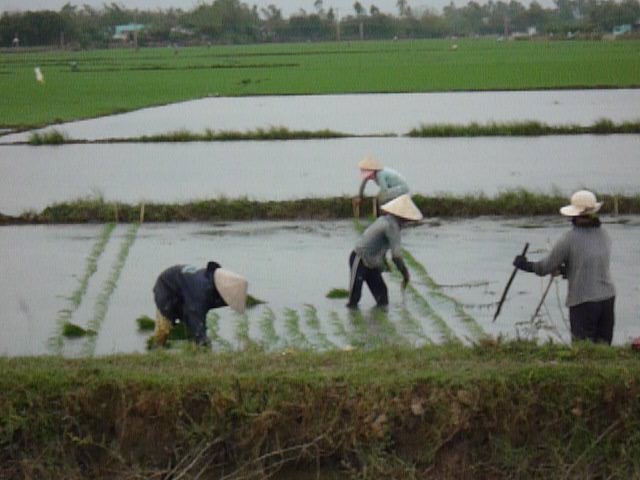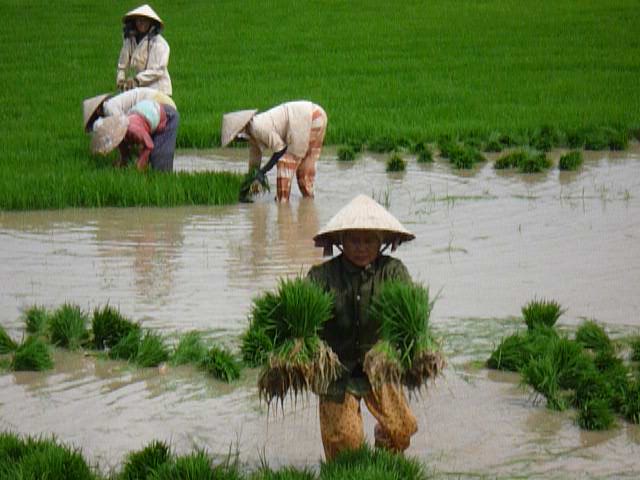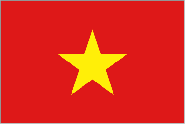CBA Viet Nam: Sustainable Agricultural Production and Food Security at Phuoc Hoa Commune
Project Overview
The Phuớc Hòa commune, Tuy Phuớc district, in Viet Nam’s Bình Định province, is located in a flood-prone area at the confluence of two rivers. In recent years, unexpected changes in floods, saltwater intrusions, rainy seasons and storms have seriously affected the province’s agricultural production and destroyed not only hectares of lands but also dams, reservoirs, canals and dikes. A local dedication to rice monoculture, with very few other employment opportunities, has resulted in a low and unstable per capita income of less than VND 500,000 a month. Over 10% of households are considered to be impoverished.
This Community-Based Adaptation project aims to help minimize losses and reinforce adaptation to flooding and saltwater intrusion. It encourages the use of climate-resilient plant varieties and cultivation measures, with a focus on rice production, to improve both agriculture-derived income levels and the commune’s food security.
* This project is part of Viet Nam's Community-Based Adaptation portfolio. *
Project Details
Phuoc Hoa Commune, Tuy Phước district is located in the Bình Định province, a coastal province of southern Central Vietnam. The commune’s population of 13,613 people is divided into 9 hamlets at sea level, with a poverty rate of over 10%. Rice monoculture production is the main cash crop and rice is also a crucial contributor to local food security.
Due to its location at the confluence of the of Kôn river and the Hà Thanh rivers, the district is frequently affected by floods and heavy rains. In recent years, unexpected changes in floods, saltwater intrusions, rainy seasons and storms have seriously affected the province’s agricultural production and destroyed not only hectares of lands but also dams, reservoirs, canals and dikes. The most damaging effect has been caused by the loss of thousands of tons of rice seeds, jeopardizing food security and living conditions in the region. The population therefore needs support to increase its productive capacity, enhance the efficiency of rice production, secure its living conditions and ensure income and food security.
This Community-Based Adaptation project experiments with the transformation of rice cultivation and builds demonstration models of adaptive sustainable rice production. It seeks to strengthen awareness and local capacity of the community to better adapt to climate change and contribute to the local sustainable development of the region. The project is carried out on a total natural area of 2,001 ha with 662 ha of agricultural land (mainly rice-planting land and few other plants such as corn, groundnuts, soybeans, vegetables, and forest trees on a limited area) as well as 350 ha of extensive aquaculture ponds (raising of shrimps, crabs, and fishes).
The two specific objectives of the project are (1) To build demonstration models of sustainable rice production that are adaptable to flooding and salt water intrusion, and (2) To raise awareness and capability of local government authorities and local people in adapting to climate changes for local sustainable development in general and agricultural production in particular.
To achieve these objectives, the project will implement an awareness campaign, develop a model of applying agricultural technology advances to minimize effects of flooding and salt water intrusion in the locality, and disseminate lessons learned. About 60 households in Phuớc Hòa commune are expected to benefit from the project, with a prospective stable income increase of 15-20%. Information on the model will be widely disseminated and the model results will be replicated and expanded to other neighboring localities with technical assistance in project transfer.
Key Results and Outputs
Objective 1 : Demonstrate sustainable rice production to adapt to climate change- induced flooding and salt water intrusion.
Select 5-10 flood-resistant and 5-10 salinity-resistant rice varieties and work with community to choose 1-2 varieties of each type to adopt and cultivate on local rice paddies (Output 1.1). Design a sustainable model of intensive cultivation with community input, including training and the integration of traditional knowledge to implement project activities within 60 households (Output 1.2). Hold 6 technical trainings that cover climate change impacts and flood/salinity-resilient cultivation techniques with 300 participants, providing 60 households with financial assistance and enabling the spread of knowledge beyond the project area (Output 1.3)
Objective 2: To strengthen awareness and local capacity to adapt to climate change, contributing to local sustainable development in general and agriculture in particular.
Improve awareness and knowledge on climate change and adaptation measures, including through flyers, panels, talks, dialogues, and tours (Output 2.1). Develop a plan to expand the project model to all vulnerable areas within the commune, and integrate adaptation measures into local community meetings (Output 2.2). Disseminate lessons learned and organize workshops/study tours for community members at communes with similar conditions to Phuoc Hoa (Output 2.3).
Reports and Publications
PIFs
CBA Viet Nam - Binh Dinh (Phuoc Hoa) - Project Proposal (EN)
Monitoring and Evaluation
Monitoring and evaluation for community-based adaptation is a new field, and the CBA project is piloting innovative approaches to evaluating the success of locally-driven adaptation projects, and generating lessons to inform ongoing practice.
Key considerations in M&E for CBA include:
- Grounding M&E in the local context: M&E for CBA should avoid overly rigid frameworks, recognizing community heterogeneity and maintaining local relevance
- Capturing global lessons from local projects: CBA projects are highly contextualized, but lessons generated should be relevant to stakeholders globally
- Incorporation of both quantitative and qualitative indicators: to ground projects in tangible changes that can be objectively evaluated, and to capture lessons and case studies for global dissemination
To these ends, the CBA project uses three indicator systems: the Vulnerability Reduction Assessment, the Small Grants Programme Impact Assessment System, and the UNDP Climate Change Adaptation Indicator Framework.
The Vulnerability Reduction Assessment (VRA)
The VRA is a question-based approach with the following aims:
- To make M&E responsive to community priorities
- To use M&E to make projects more accountable to local priorities
- To make M&E capture community ideas and local knowledge
- To gather community-level feedback to guide ongoing project management
- To generate qualitative information
- To capture lessons on specific issues within community-based adaptation
- To generate case studies highlighting adaptation projects
The VRA follows UNDP's Adaptation Policy Framework, and is measured in a series of meetings with local community stakeholders. In these meetings, locally-tailored questions based on standard VRA questions/indicators are posed, and the community assigns a numerical score on a 1-10 scale for each question. Progress is evaluated through changes in scores over the course of implementation, as well as through qualitative data collected in community discussions surrounding the exercise.
UNDP has developed a Users Guide to the VRA (Espanol) (Francais) as a tool to assist practitioners to conceptualize and execute VRA measurements in the context of CBA projects.
The SGP Impact Assessment System (IAS)
The CBA, being a project of the GEF Strategic Priority on Adaptation, aims to increase the resilience of ecosystems and communities to the impacts of climate change, generating global environmental benefits, and increasing their resilience in the face of climate change impacts. To this end, the CBA projects use the SGP's impact assessment system for monitoring achievements in GEF focal areas (focusing primarily on biodiversity and sustainable land management).
The IAS is composed of a number of quantitative indicators which track biophysical ecosystem indicators, as well as policy impact, capacity development and awareness-building.
UNDP Climate Change Adaptation Indicator Framework
CBA projects also track quantitative indicators from UNDP's adaptation indicator framework, corresponding to the thematic area on natural resources management. More information on UNDP's indicator framework can be found on the UNDP climate change adaptation monitoring and evaluation website.
* This description applies to all projects implemented through UNDP's Community-Based Adaptation programme. Specific details on this project's M&E will be included here as they become available. *






